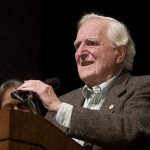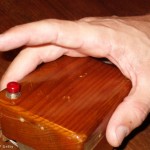
On 9 December, the renowned Computer History Museum in Mountain View, California paid a tribute to Douglas Engelbart, who passed away at the age of eighty-eight on 2 July. It was 45 years earlier, on 9 December 1968 that he had demonstrated the fundamental features (expected to become reality) of the modern personal computer in a ninety-minute presentation delivered at a conference in San Francisco. The event is now referred to as “the mother of all demos” in computer history.
Engelbart’s name is inseparable from the computer mouse, hyperlinks, interactive computing, and collaborative work with computers. He gained fame for the invention of the computer mouse, although it was merely a by-product of his research. Engelbart's views were profoundly influenced by the article As We May Think published by the visionary Vannevar Bush (1890-1974), who had envisioned memex, an advanced network. In World War II, Engelbart served as a technician in the Philippines, where he read Bush's essay on ways of making human knowledge widely accessible. He was also inspired by Benjamin Lee Whorf's (1897-1941) principle of linguistic relativity: if the complexity of a language determines the complexity with which the speakers of that language think, then prevailing technological levels, too, crucially influence our ability to manage information, and this fact leads to the emergence of increasingly advanced technologies. Information is managed, and knowledge is processed by individuals or groups the most efficiently by using computer methods, and computers arranged in a network clearly increase the intellect – Engelbart drew the conclusion in his key work Augmenting Human Intellect: A Conceptual Framework published in 1962. The following year Engelbart was appointed the head of the Augmentation Research Center (ARC), which he had founded at the Stanford Research Institute (SRI).
Long before personal computers, his research team developed theories for special screens, groupware, graphical user interfaces, hyperlinks and hypertexts that abandoned the linearity of text documents and adopted something similar to the way the human brain works; his group also tried to implement these theories in practice.

He invented the computer mouse described as "X-Y position indicator for a display system" in 1967. Yet he did not make a fortune out of it: two Canadian engineers had already produced something very similar in 1952, what's more, subsequent, widely used versions were based on different mechanisms, and the patent already expired in 1987 before the widespread use of the mouse.
Since Engelbart's research and development aimed at interactive human-computer interfaces supporting online collaboration were partly funded by ARPA, it is not surprising that ARC also contributed to the creation of ARPANET, the precursor to internet, which was launched on 29 October 1969. The first connection was created between ARC and one of the labs at UCLA. By 5 December, UCSB and the University of Utah were also connected, and thus the first four nodes of the prehistoric web were established. ARC soon evolved into the first Network Information System that provided smooth connection between the nodes.
In the early 1970s, the majority of Engelbart's best researchers left to join the Xerox PARC team that was engaged in work on personal computers at full speed. Moreover, funds from NASA and ARPA dwindled after the end of the Vietnam War and the Apollo Program, and what remained of ARC was placed under the control of artificial intelligence researcher Bertrand Raphael, then transferred to a company called Tymshare. Engelbart, who always held views differing from prevailing paradigms in technological development, grew marginalized. His ideas attracted some interest, but he was unable to acquire sufficient funds for their implementation. However, for the sake of objectivity, it must be added that the researcher, who had grown used to mainframes and collaborative work, saw the near future in timesharing, client-server based computing even in the early 1970s, while Engelbart's younger colleagues favoured personal computers. The "Engelbart renaissance" came about in the late 1980s and the '90s, strengthening with the spectacular spread of the World Wide Web, and bringing Engelbart recognition expressed in a great number of prizes and awards.
In the meantime, he founded the Doug Engelbart Institute (http://www.dougengelbart.org/) in 1988, which focuses on "augmented knowledge", "collective IQ", and enhanced performance of computer systems (a number of interesting projects are currently in progress). One starting point for their research is bootstrapping: a self-developing system where a single change supports – and changes – change itself in an adaptive way to generate newer and newer changes.
